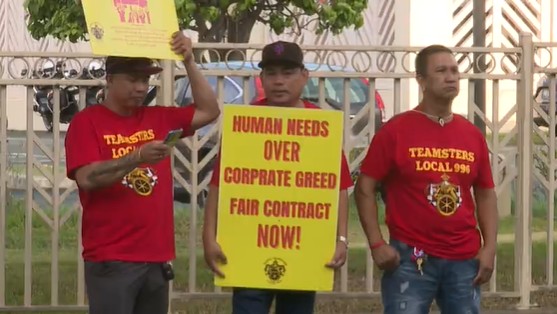HONOLULU (KHON2) — Thousands of healthcare workers are taking a stand for better pay, safer staffing, and improved working conditions — as one major hospital strike ends and another begins in Hawaiʻi.
More than 30,000 Kaiser Permanente nurses and healthcare professionals from California and Hawaiʻi wrapped up a five-day strike this week, calling it a major step forward in the fight for patient safety.
Represented by the United Nurses Associations of California/Union of Health Care Professionals (UNAC/UHCP), the workers walked out of more than 500 Kaiser facilities across California and Hawaiʻi. Union leaders said the demonstration sent a message that unsafe staffing can no longer be ignored.
“The Joint Commission has finally said what nurses have known all along: unsafe staffing is unsafe care,” said UNAC/UHCP President Charmaine Morales, RN. “Employers like Kaiser can no longer treat staffing like a budget line. It’s now a national patient safety mandate.”
Negotiations between Kaiser and the Alliance of Health Care Unions are scheduled to resume Oct. 28 and 29.
Meanwhile, on Oʻahu, hundreds of healthcare workers at Kapiʻolani Medical Center for Women & Children are now on strike — accusing hospital management of bad faith bargaining and unfair labor practices.
Represented by Teamsters Local 996, workers include a wide range of essential hospital staff such as surgical techs, dietary workers, maintenance staff, and nurse aides.
Union leaders say the decision to strike came after months of stalled negotiations and repeated rejections of proposals for fair pay and working conditions.
“We’ve been at the table since May, and what the company’s offered is not what our people deserve,” said Sandy Chung, with Teamsters Local 996. “The cost of living in Hawaiʻi is ridiculous. The majority of our people at Kapiʻolani are living in poverty — but this isn’t just about wages. It’s about respect and better working conditions.”
The hospital said there have been 12 negotiation sessions with the union since May and they remain willing and available for further discussions and are committed to reaching an agreement as soon as possible. Kapiʻolani added that committees last met for negotiations on Sept. 25 and there have been further discussions, however, there are no new negotiation sessions scheduled at this time.
Workers say they were offered a 3% raise plus a bonus, while non-union employees received 4% just before the strike began. The union also accuses the hospital of hiring replacement workers from out of state instead of resuming good-faith negotiations.
However, Kapi‘olani Medical Center for Women & Children chief operating officer Gidget Ruscetta said that the hospital decided the Teamsters members deserved a wage increase before they were even notified about the strike. In an e-mail the hospital said: “We gave them a pay raise and a competitive pay adjustment from the first year of our proposal that together average more than a 4% increase and we also gave a bonus. We notified the union of our intention to do this on Sept. 29. We received a strike notice from Teamsters on Oct. 6.”
“It’s very disheartening to know the employer brought in staff to do our work instead of trying to negotiate a fair deal,” said Jonathan Makue, lead negotiator for Teamsters 996. “Not once do I feel the employer has negotiated in good faith.”
Kapi‘olani Medical Center for Women & Children said the temporary workforce is in place to ensure patients continue receiving exceptional care. In an e-mail the hospital said, “They are serving all the needs of our medical center until the union decides this strike is over and our staff represented by the Teamsters return to their jobs. In the first 48 hours since the temporary staff started, there were 213 visits to our Emergency Department, 29 surgeries and 20 babies born.”
Teamsters 996 says the strike will continue “as long as it takes” until hospital leadership agrees to a contract that supports both workers and patient care.
